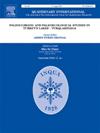Decoding late Quaternary paleoclimatic signatures from the western Bay of Bengal: A multiproxy approach
IF 1.8
3区 地球科学
Q3 GEOGRAPHY, PHYSICAL
引用次数: 0
Abstract
Investigating climate teleconnections and their feedback mechanisms in the global climate system during the late Quaternary period is indispensable in combating the adversities of climate change due to global warming and achieving reliable climate predictions. Even though the Indian monsoon system is a major component of the global climate and hydrological system that gets severely impacted by other climate variables and natural climate forcings, its responses and linkages with different climate parameters remain poorly understood. The Bay of Bengal (BoB), a prominent sub-basin of the Northern Indian Ocean, receives rainfall mainly from the Indian Summer Monsoon (ISM) and partly from the Northeast Monsoon (NEM). Further, the basin receives a large quantity of fluvial sediment discharges from both the Himalayan and peninsular rivers. Considering the unique geo-environmental settings of the BoB and its teleconnection with global climate forcings, the present study has attempted to address the paleoclimate and paleoceanographic variability and their plausible linkages with the global climate system using a marine sediment core of ∼2.90 m retrieved from the western BoB. The chronology of the core was established using AMS radiocarbon dates, while past climate and oceanographic conditions were reconstructed through a multiproxy approach. The present study demonstrated a plausible dominance of terrestrially derived C4 plants during 45−15 ka. Further, the study also suggested a conspicuous increase in the in-situ calcareous productivity observed during 25−14 ka and the last 4 ka associated with poor freshwater stratification. Conversely, the strengthened ISM during 12–4 ka resulted in enhanced freshwater inflows and prominent stratification in the western BoB, inhibiting in-situ calcareous productivity. The present study has implications for millennial-scale hydroclimate changes in the BoB and its linkage with the regional and global climate dynamics.
孟加拉湾西部晚第四纪古气候特征的解码:一个多代理方法
研究晚第四纪全球气候系统中的气候遥相关及其反馈机制对于应对全球变暖带来的气候变化不利影响和实现可靠的气候预测是必不可少的。尽管印度季风系统是全球气候和水文系统的主要组成部分,而全球气候和水文系统受到其他气候变量和自然气候强迫的严重影响,但人们对其响应及其与不同气候参数的联系仍然知之甚少。孟加拉湾(BoB)是北印度洋一个重要的子盆地,其降水主要来自印度夏季风(ISM),部分来自东北季风(NEM)。此外,该盆地还接收了喜马拉雅河和半岛河排放的大量河流沉积物。考虑到青藏高原独特的地质环境背景及其与全球气候强迫的遥相关,本研究试图利用从青藏高原西部获取的约2.90 m海洋沉积物岩心来解决古气候和古海洋变率及其与全球气候系统的似是而非的联系。利用AMS放射性碳定年法建立了岩心的年代学,并通过多代理方法重建了过去的气候和海洋条件。目前的研究表明,在45 ~ 15 ka期间,陆地衍生的C4植物似乎占主导地位。此外,研究还表明,在25 ~ 14 ka和最后4 ka期间,与淡水分层不良有关的原位钙质生产力显著增加。相反,在12-4 ka期间,ISM的增强导致淡水流入增加,并在BoB西部形成明显的分层,抑制了原位钙质生产力。本研究对青藏高原千年尺度的水文气候变化及其与区域和全球气候动力学的联系具有启示意义。
本文章由计算机程序翻译,如有差异,请以英文原文为准。
求助全文
约1分钟内获得全文
求助全文
来源期刊

Quaternary International
地学-地球科学综合
CiteScore
5.60
自引率
4.50%
发文量
336
审稿时长
3 months
期刊介绍:
Quaternary International is the official journal of the International Union for Quaternary Research. The objectives are to publish a high quality scientific journal under the auspices of the premier Quaternary association that reflects the interdisciplinary nature of INQUA and records recent advances in Quaternary science that appeal to a wide audience.
This series will encompass all the full spectrum of the physical and natural sciences that are commonly employed in solving Quaternary problems. The policy is to publish peer refereed collected research papers from symposia, workshops and meetings sponsored by INQUA. In addition, other organizations may request publication of their collected works pertaining to the Quaternary.
 求助内容:
求助内容: 应助结果提醒方式:
应助结果提醒方式:


